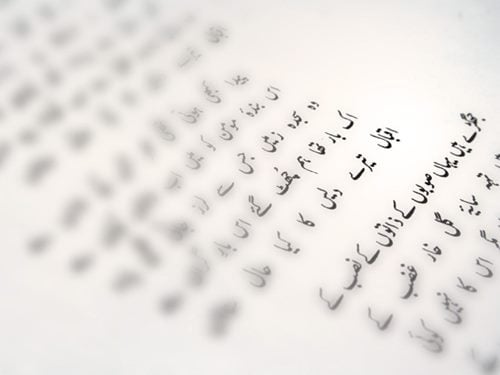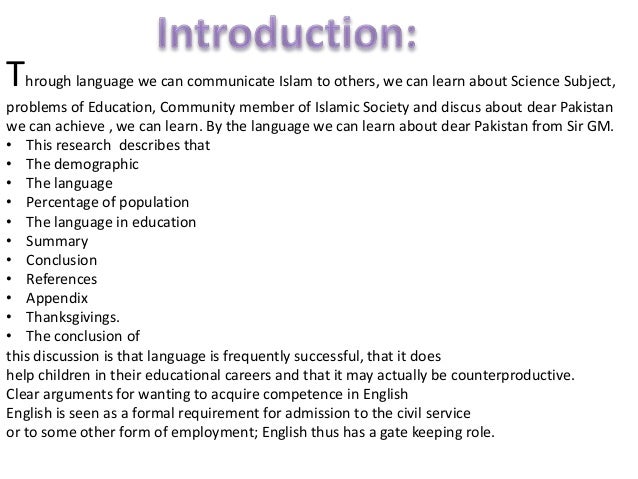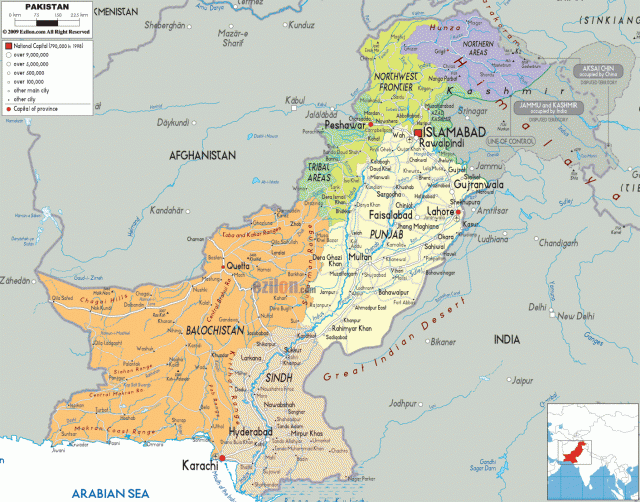Who Speaks Urdu In Pakistan Hindi is the official language of the Republic of India (projected to overtake China as the world's most populous nation by 2030) and the most widely spoken language in South Asia. It is also the language of a long literary tradition, both in modern prose and poetry, as well as pre-modern secular and devotional poetry. It is also a tremendously important language strategically in South Asia.In their basic form Hindi and Urdu are generally considered to be the same language written in two different scripts.
After one year of instruction, you could go to India or Pakistan and talk about yourself, where you were born, where you grew up, what you do, your interests and your attraction to South Asia and South Asian languages. Each lesson builds on previous lessons in a systematic way to allow the absorption of vocabulary words in an organic manner, while reinforcing grammatical structures. The text is accompanied by a CD as well, and a supplementary text introduces Urdu script quickly and painlessly. Films are also shown occasionally in class to reinforce the structures and idiomatic expressions that are being taught. It is also very closely related to the scripts employed to write Punjabi, Bengali, Gujarati, and Oriya among others.
In this way, too, Urdu not only cannot be restricted to Islam since so many Muslims and non- Muslims use it, as well as different ethnic groups. In addition to Punjabis using the language, Pashtuns, Sindhis, Balochis, Biharis, Delhiites, Kashmiris, and Uttar Pradeshis make up the majority of Urdu speakers, who comprise of multiple ethnic groups . Along these lines, Urdu should be viewed as a language that is not limited to one group of people; it serves as an intermingling of cultures, according to Inder Jit Lall.
Lall, literary critic, translator, author, and promoter of the study of Urdu literature. He shows how Urdu's vocabulary includes words from Hindi, Arabic, Sanskrit, Persian, English, Pali, Punjabi, and Portuguese . In this manner, Urdu represents a shared language that the different ethnic groups—who have their own languages—can use to converse outside of their mother culture group. By doing so, they retain their own separate culture and not some fabricated "ethno-linguistic group" that Harris Khalique attests is impossible to do. Khalique, writer and poet, states that those who claim to be solely "Urdu-speaking" are in the wrong for trying to claim Urdu as part an "ethno-linguistic group" that does not exist.
In this sense, Urdu should continue to be promoted and should be revived as a language that supports interethnic communication. The Pakistanis and Indians who have emigrated to the United States, Canada, United Kingdom, Saudi Arabia, and the United Arab Emirates converse in Urdu to stay close with their own people, even if Urdu is not their mother tongue . David, Nice article, but...As is evident from the comments on your article, an overwhelming majority of living speakers of Urdu and Hindi do not know much about the origin or divergence of the language.
Unfortunately, your article does not address the question you ask nor does it inform much of the history. Despite some present differences, Urdu and Hindi are almost completely mutually intelligible by the common speakers save for some vocabulary and the written script. As some have noted on this thread, the origin is from Pali and Prakit class of languages and divergence is political. Unlike common belief by Hindi speaking Indians, Urdu is not Hindi with a lot of Arabic. It has loan words from local Indian languages, Farsi, Arabic, Turkish and English. Urdu and Hindi meant the same to literary greats like Ghalib who is thought to have used the work Hindi to refer to the language he wrote in, Urdu.
Finally, there is no reason for the language to become the same any more then they already are or not to do so. Natural cultural and political pressures will determine what they diverge further, remain the same, or converge. Fresh data from the 2011 census says that Urdu is the seventh most spoken language in India.
It is one of the 22 official languages recognised in the Constitution of India, having official status in Telangana, Uttar Pradesh, Bihar, Jharkhand, Bengal and Delhi, while it has the status of official language of Jammu and Kashmir. Urdu is the national language of Pakistan and is a registered regional language of Nepal. Urdu is a Central Indo-Aryan language that is the official national language of Pakistan and is one of India's many constitutionally recognized official languages.
It is spoken by approximately 70 million people worldwide natively. Urdu is Pakistan's lingua franca, and while only 7% of Pakistanis speak Urdu natively, most Pakistanis understand Urdu and speak it as a second language. As the Mughals declined, the need to preserve its culture led to the implementation of "schools, the printing press, an orderly bureaucracy and the concept of the unity of India" . Schools, such as madrassas , were taught in Urdu and served to enhance Urdu's tie with Islam in addition to the mullahs' extensive use of Urdu in correspondence between one another and to the Muslims coming to them to learn. As the Mughals, or "Muslim invaders," brought about this formation of a new language, Urdu became synonymous with Muslims, especially since it was written in the Nastaliq script.
The Sufis, Islam's mystics, though, as opposed to the ordinary Muslim Mughal, contributed the most in this respect when they began to use "Hindvi" because the locals did not understand Persian or Arabic . Rahman shows this strengthening of Urdu's tie to Muslim identity during the nineteenth century when Muslims were trying to create a new state for themselves. Along the road to independence, the Indian Muslims used Urdu to further distinguish themselves from the Hindus, which led to the recognition of Urdu as the language of Islam in the Subcontinent.
From this point on, the language continued to have an Islamic tie to it, and is currently shown through Pakistan's use of the language as their national language. It is also spoken in India and is one of the country's 22 official languages that are recognized by its national constitution. There are roughly 69 million people in the world who speak Urdu as their native language. Another 101.6 million people speak Urdu as their second language. For this reason, the demand for Urdu interpreters is increasing by the day. In India it is the official language of Punjab state and one of the 15 official languages recognized by the Indian constitution.
It is also spoken in the neighboring states of Haryana and Himachal Pradesh. In addition about 25 percent of the people living in the New Delhi metropolitan area speak punjabi in everyday life. 15 million people in Pakistan (8% of the population) speak Urdu as their first language, and over 90% rely on it to communicate. But the education system teaches its students the country's national language as if it were a foreign one, and completely forgets the regional languages spoken in various parts of Pakistan. Around one-third of Pakistani students attend private schools, where English is the first language.
The public, government-funded schools mainly teach in Urdu. SOON after the partition of the subcontinent into India and Pakistan, especially after India had taken Hindi as the official language, central leaders of Pakistan wanted Urdu to be the sole state language of entire Pakistan. This is a decision which had been strongly opposed by the people of East Pakistan. With the utmost surprise of the history of the language movement, Urdu itself has never been the most widely spoken language of Pakistan till now.
During the movement, it was the language of only 7 per cent of the total population of Pakistan while Bangla accounted for 54 per cent.The mother tongue of most of the West Pakistanis were Panjabi, Pashtu, Sindhi, Balochi and so on. Urdu uses a modified form of Perso-Arabic script known as Nastaliq (nastaʿlīq). According to research done in 2021 estimates, Urdu is the 21st most spoken first language in the world, with approximately 61.9 million who speak it as their native language. According to Ethnologue's 2018 estimates, Urdu is the 10th most widely spoken language in the world with 230 million total speakers, including those who speak it as a second language. Ultimately, Urdu remains a conundrum in terms of how it should be framed because of its myriad uses for diverse groups of people. Thus, when it comes to whose language is Urdu, Urdu may belong to no one and everyone at the same time.
Instead, it may only matter that people continue to support the existence of Urdu. Urdu seems to serve as a facilitator between these competing groups in communication, politics, and the arts, while also allowing those in the Subcontinent to cling to their own mother tongue and culture. An impressive research article by a non-subcontinental person on Urdu and Hindi.
But the fact is that most of the people who think they are specking Hindi are really specking Urdu because of the Persian and Arabic derived words / vocabulary they use. If they really spoke a Sanskrit laden Hindi language, even they won't understand it themselves about what they are saying. Just listen to the so called Hindi in some popular Indian movies, they are all talking in Urdu!
If you want to listne to real Hindi, go watch Maha-Bharta like Indian religious movies. Let see how much the Hindi speaking Indians themselves understand the language spoken in it! Now a correction to a quote - "and provided appropriately Sanskrit-derived alternatives. Maaf kijie." --- not-true. The word Maaf is derived from Arabic word Mu'aaf into Urdu.
I believe no language is superior or inferior, for each person the sweetest language is their mother tongue. Urdu and Hindi can never be one language because of scriptures of Hindu religion and Muslim religion are written in different scripts. I think there is a simple and practical reason why Hindi and Urdu have evolved as two separate languages. Original Hindu Scriptures in Sanskrit were written using Devanagari script. Since Sanskrit had gone out of day-to-day speaking without Hindi language embracing the Devanagari script, the Hindu Scriptures would have become inaccessible to the general public.
Before the British arrived in India, the official works in the courts were done in Farsi written in Arabic Script. And most of the record keepers were Hindus who were proficient in Farsi. Even now, there are few Hindus and Sikhs who write in Urdu, even Indian PM Manmohan Singh could not read Hindi script, and his speeches were written in Urdu script.
More shocking were legislations in many states which made it an offence for government servants to use any language other than Hindi. In May 1948, the UP government issued a circular which stated that the children would be educated using Hindi exclusively. But in 1949, an important resolution was adopted at the Provincial Education Ministers' Conference, which was also approved by the Union government. In Pakistan, Pashto, the official language of neighboring Afghanistan, Pakistanis speaking Pashto who lives in Quetta and Peshawar. This Pakistani language is spoken by more than 15.42 percent of the country's population.
Pashto speakers are primarily found in Pakistan's northern Balochistan, Federally Administered Tribal Areas, and Khyber Pakhtunkhwa provinces. This language is also used amongst Pashtun groups in the country's cities. Khushal Khan Khattak, Rahman Baba, Khatir Afridi, and Ghani Khan are just a few famous poets written in Pashto. Although Urdu is the official national language, it is spoken as a native tongue by only 8 percent of the population. People who speak Urdu as their native language generally identify themselves as muhajirs. A large number of people from educated backgrounds speak Urdu, as opposed to their natal languages, in their homes, usually to help their children master it.
Urdu as a language evolved during the last days of the Mughal rule in India. Persian was the official language of the Mughal emperors along with Turkic and Arabic. At that time, the northern part of India was the centre of rule and knowledge, particularly Delhi and its surrounding areas, including today's Bihar and Uttar Pradesh. Due to the interaction of local population and the ruling Persian-Turkic-speaking Muslim elite, a new language evolved and was known as Hindustani. So, Urdu became one of the signs of era of prosperity and power of the Muslims in this sub-continent.
Punjabi is much more respected, spoken, admired and recognized as a great language in the Indian Punjab than in Pakistani Punjab and even Sindhi has got an official status in the Indian Constitution. One of the major indicators of accent difference, on top of sound errors, can be incorrect intonation patterns. It is not uncommon to apply the speech intonation of the mother tongue onto the target language. Work on linking your words together in English phrases and try to replicate the melody and rhythm of English native speakers. English and Urdu both belong to the Indo-European language family but they stem from very different branches. In contrast, Urdu belongs to the Indo-Iranian group of languages.
Where English applies a latin alphabet, Urdu has its own unique alphabet and sound system. In fact, it is very hard for Urdu words to be written out with English lettering, as Urdu contains many sounds that are not present in English. As a result, the sound code of Urdu heavily influences how English is spoken by Urdu native speakers in the region. This is what can account for communication breakdowns with other international dialects and accents of English. In practice, these guarantees meant very little for Urdu-speaking people. Urdu was born in India and Islam has nothing to do with it.
Precisely how could Urdu-speaking people conserve their culture when soon after independence their mother tongue was banished from primary schools? Throughout the large areas of northern and central India , Urdu was virtually removed as a medium of instruction in schools. Although it is considered to be predominantly inhabited by Urdu-speaking people, the city of Karachi is the most linguistically diverse city in Pakistan. Being the county's most populated city, one finds a remarkable treasure trove of languages here. If the latest census results hold any meaning, the percentage of the Urdu-speaking population in Karachi has rather been decreasing with the influx of people speaking other languages.
The religious revivals of the 19th century have to be examined in the wider context of the anti-colonial freedom movement of the 20th century. The Indian National Congress claimed to represent all Indians irrespective of religion. It declared Hindustani, the common vernacular of north India with the Devanagari and Persian scripts, as the national language of a future independent, united India.
The All-India Muslim League rejected the INC's claim to represent all Indians. Instead, the Muslim League, as it has come to be known, claimed to represent all Indian Muslims. It rejected Hindustani as the national language and declared Urdu to be the official language of Indian Muslims.
During much of the time of Sikh gurus and Sufi saints, the official language of Punjab was Persian. The state officialdom largely hailed from the Turco-Afghan nobility and conducted their affairs in Persian. This nobility owed loyalty to the ruler of Delhi and, later as the Mughal Empire declined, to the master of Kabul. In northern India, the common lingua franca was Hindustani.
In literary usage, this language either took the form of Hindi written in the Devanagari script or of Urdu penned in the Persian script. Toward the end of Mughal rule, Urdu began to be cultivated by the urban literati even as Persian continued to the official state language. Urdu is not the Pakistani language, nor is Hindi the Indian. Urdu and English are the official languages of Pakistan, but only 8% of the population claim to be native speakers of Urdu. In fact, Punjabi is much more widely spoken across the country. Hindi and English are the official languages of India, but each state and union territory is free to choose their own official language; eight have chosen Urdu.
Urdu is not only the official language of Pakistan but also the national language of the country. However, only about 8% of Pakistanis speak Urdu as their first language. However, a vast section of the population speaks it as their second language. The origin of Urdu goes back several centuries, and according to some historians, Urdu has evolved from an Indo-Aryan language spoken in the area around Delhi which absorbed words from Arabic, Persian, and Chagatai. The Government of Pakistan has strived to promote the national language of Pakistan to encourage national solidarity.

























No comments:
Post a Comment
Note: Only a member of this blog may post a comment.